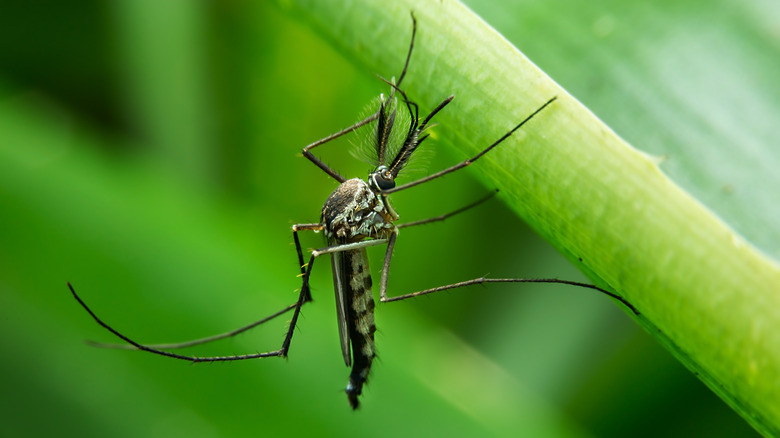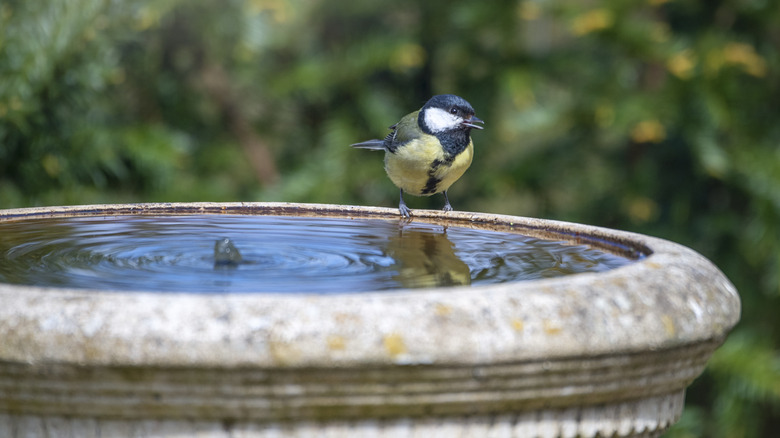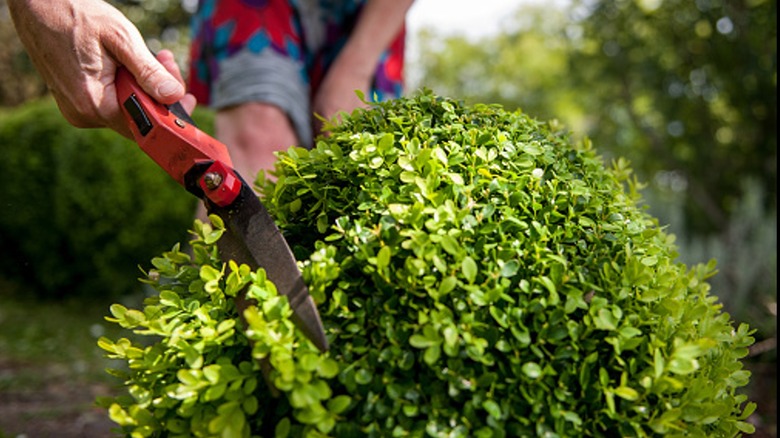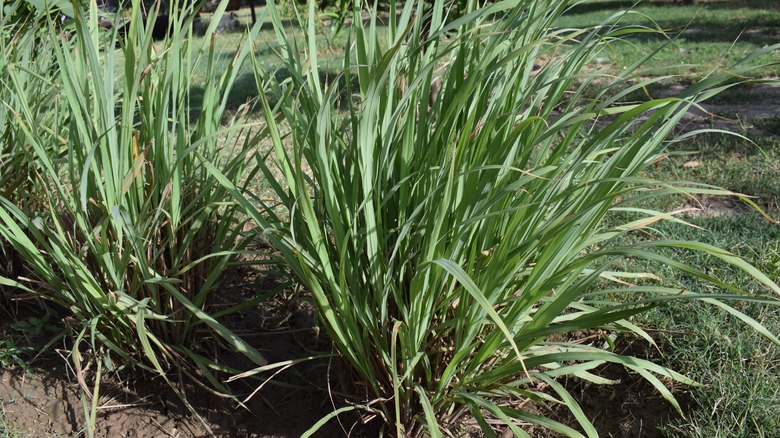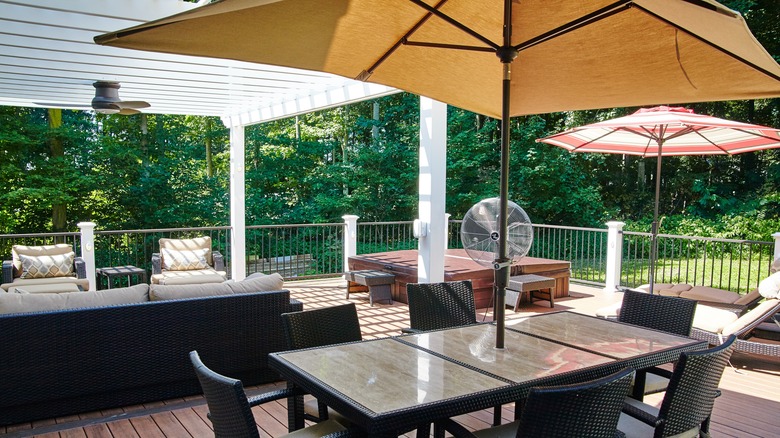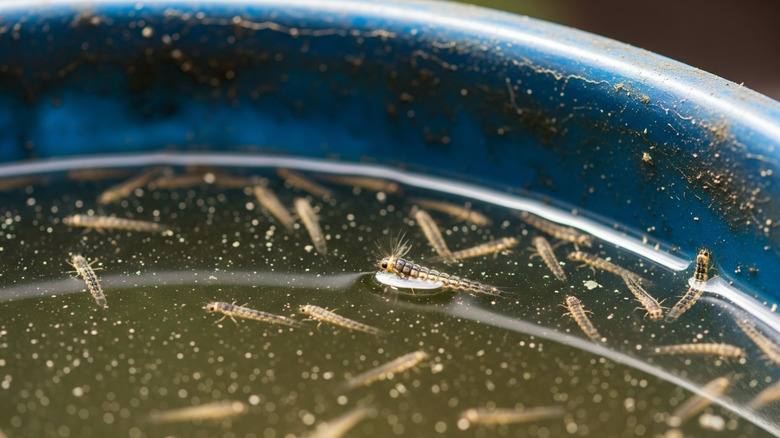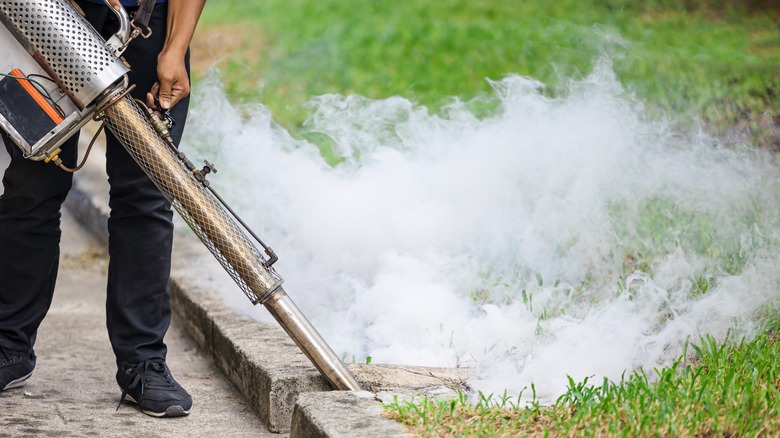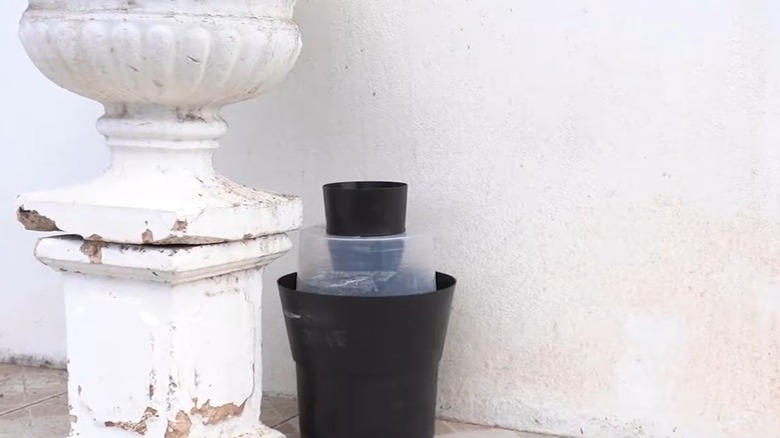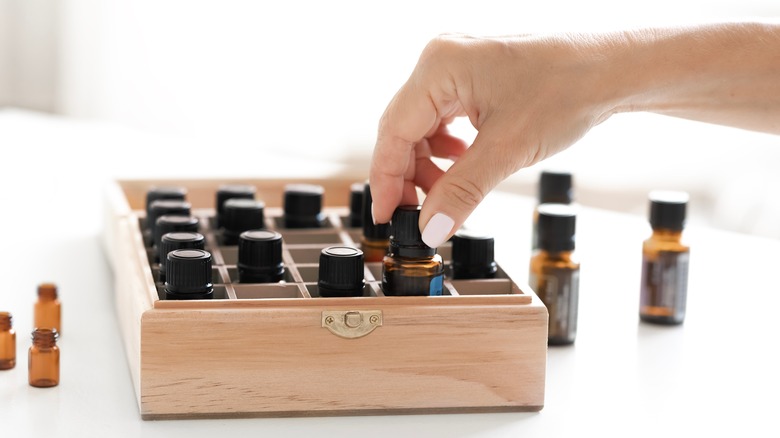Kick Mosquitoes Out Of Your Patio Space With 9 Pest Control Tips
Summer is the time for mosquitoes and their incessant buzzing, which can ruin your time in your outdoor spaces. Having a glass of wine on your balcony or an outdoor dinner on your deck isn't as relaxing when you feel your shins get bit up. Because of this, you'll want to pull out all the stops to prevent the bloodsuckers from kickstarting a war of swats, creeps, and prickles on your patio, and what better way to deal with the problem than making your backyard as unhospitable to them as possible? The easiest way to prevent them from biting is to remove anything that attracts them — from standing water to bushy shrubbery — and then implement some extra strategies that will deter those who are still curious and come buzzing around.
Sometimes these blood-leechers may come buzzing because your yard is transmitting mixed signals, as Matt Rogers, CEO and Co-Founder of Pestie, explains in an exclusive House Digest interview. According to him, while you can light all the citronella candles you want, if you have standing water, poor yard maintenance, and ill-thought-out landscaping, mosquitoes will treat patios as their breeding playgrounds. Doing away with them is what effective pest control is all about, as you'll discover below.
Remove the mosquitoes' breeding grounds by eliminating standing water
While you wouldn't want to spend a greater part of your existence looking for a new home every time it gets warm and sunny, mosquitoes aren't wired that way. "They spend most of their lives looking for food sources and places to breed and lay eggs," shares Rogers. And mind you, find they will, as even a teaspoon of water is plentiful for their tiny eggs — just ask the annoying Asian tiger female mosquitoes. As long as the water has been there for a minimum of a week and harbors organic materials like leaves or bird droppings that keep vicarious decomposing microbes busy, mosquitoes will swarm to it. They will use it both as a breeding ground and a ready food source for their emerging offspring.
So, how do you get rid of mosquitoes in your yard, according to our expert? The easiest way to do so is to get rid of any standing water. "If your yard does not offer them a breeding ground, they are naturally going to move on to other locations," Rogers shares. To do that, you must venture around your patio and inspect for any pooling water. This means that a poorly draining flower pot or the water-laid wheelbarrow gets tipped. Similarly, the birdbath is treated to weekly squeaky-clean routines. Solid lawn chairs are replaced for the ones with slats to prevent water pooling. Anything unamenable to dumping or consumption (think pools, rain barrels, or fish ponds) must get treated to mosquito dunks monthly, which won't harm your pets or the backyard wildlife. These are small granules that contain bacteria that kill mosquito larvae, controlling your pest issue.
Keep lawns and shrubs trimmed short
Removing all standing water in your yard isn't enough to keep these pesky bugs off your patio since they come armed with wings. While not exactly long-distance fliers — unless we're discussing the impressive performance of saltmarsh breeding mosquitoes that fly 100 miles out — mosquitoes can hazard a 3-mile-long flight on average, with 15 miles capping their best performance. This means they're in constant need of resting stops, and will descend upon your patio if they spot welcome signs of clutter. According to Rogers, "Long grass and overgrown shrubs create an ideal, protective environment for mosquitoes and other pests to hide and nest."
The way forward? Rectify the mistakes that are attracting mosquitoes to your yard. As mosquitoes love hiding in dense vegetation, untamed perennials, potted plants, and unmowed turf, pruning or cutting them regularly is important. This will also make them easier to spot by their predators, such as birds and beneficial insects. "By keeping grass cut short and shrubs trimmed, you are limiting environments that will attract mosquitoes," Rogers shares. Other places they may hide are inside English ivy and other creeping plants, as well as organic mulches in shaded areas as they will stay moist.
Plant the right landscaping
Although choosing between native and non-native plants is more complicated than you think, one aspect is uncontestable: invasive, exotic plants invite in non-native mosquito species, including the reviled tiger mosquitoes responsible for the West Nile and zika virus. Indeed, if your yard is filled with mosquitoes, there are plenty of plants to blame, such as Brazilian Peppertree, amur honeysuckle, tree of heaven, and even zoysia grass. That's because larvae rely on decaying leaves, seeds, and other plant matter to grow, and non-native mosquito larvae have a higher survival rate when eating the debris of non-native plants.
Do you have a fully native garden but still have issues with these pests flying around? Another thing that can attract them is standing water on the leaves or blooms. Most people don't take the time to water the soil of their flower beds carefully, and instead spray water overhead and leave droplets on the leaves. Even if they did water just the soil, rain would create the same predicament. Well, this can attract mosquitoes, beckoning them to buzz around. A simple way to deter them is to blow off the droplets with a leaf blower. However, this will only work on your leafy landscaping and not your blooms, as the blower can damage the petals.
Put fans on your patio and turn them on medium or high
Want a breezy way to tell mosquitoes it's time to pack up and move elsewhere? Deck your patio with an oscillating fan. "As mosquitoes cannot fly in strong wind speeds, an overhead fan, box fans, or tower fans strategically placed on your patio can keep them at bay by literally blowing them away," explains Rogers. Indeed, as long as your fan throws winds at around 15 miles an hour, no bloodsucking critter has a decent shot at making a landing. For best results, place it near the ground and relatively close to your patio set, as this will protect you from dangerous mosquitoes like the Zika-spreading yellow fever mosquito, which prefers biting legs.
Consumer Reports even tested this theory by pitting fans, citronella candles, and repellent diffusers against each other. As expected, pedestal fans came out on top, throwing mosquitoes off-course in nearly 65% of cases. Allegedly, this success is also attributed to the fans dissipating carbon dioxide exhaled by homeowners, which usually leads mosquitoes by their noses to the patios.
Reel the breeding mosquitoes in with 'Buckets of Doom'
If you felt shaken after reading 'Buckets of Doom,' imagine mosquitoes' distress because these buckets promise everything their name indicates. Luckily, they're delightfully simple to make. Simply grab a bucket, half fill it with water, top it up with bales of hay, grass, or straw, and let it sit for a couple of days in a shaded spot — preferably one that is favored by mosquitoes but sees little human foot traffic. That's because it will initially attract a lot of mosquitoes, which can be a nuisance if you put it in an area you like to spend time in. The fermented solution will let the female counterparts know there's food to be had and a breeding place to boot. Next, destroy it — not literally, of course, but with a mosquito dunk.
Available at hardware, home improvement, or garden supply stores, mosquito dunks are circular tablets that dissolve to release Bacillus thuringiensis subspecies israelensis. This is a larvicide that targets bad actors like mosquitoes, gnats, and blackflies after they hatch. The best part, though? They're biodegradable, ensuring you don't create any unnecessary or dangerous waste. Usually, ¼ of a dunk will last you a month, but you can steep the whole donut if you like. Don't forget to refill the bucket as the water evaporates to ensure the eggs hatch within its confines (and not outside).
Disorient and eliminate dawdling mosquitoes with fogging
If you've planned an al-fresco dinner gathering but don't want your guests to continuously smack themselves, breaking out the fogger might offer some temporary respite. These systems are either available as thermal foggers (that use propane flame) or as aerosol sprayers. They work by cannoning the infested area with insecticide, such as pyrethrin or permethrin, targeting adult critters. Depending on which product you use, the insecticide can last anywhere from days to a few hours. Because of this, it's best to apply it just before your event. You want enough time to pass where the fog won't be noticeable to your guests but not so long that it will lose its effectiveness. Because of this, the results are temporary, necessitating reapplications every time you're in the mood for an outdoor dinner or happy hour.
For the best results, direct the spray to common harborage areas, such as underneath the patio furniture, alongside the potted plants, unruly shrubbery, or any other dense vegetation. Be warned, though; mosquitoes often inhabit the same spaces as pollinators and beneficial insects, so fogging these areas will kill them, too. Even if you don't fog the flower beds the bees and caterpillars like to frequent, the breeze can carry the poison to those areas, so it's best to skip this step if you notice these important insects in your garden. Moreover, fogging around vegetables and fruits makes these consumables unfit for consumption.
DIY a sugary ruse for mosquitoes
While you may believe mosquitoes are only out for your blood, that's far from the truth. Unless aiming to nourish eggs, females and their counter-equals rely on sweet nectar to maintain their bodily functions, explaining their attraction to nectar-rich plants. Unsurprisingly, such behavior fueled the imagination of entomologists, pest companies, and bug hunters alike to use mosquitoes' food habits against them and conjure numerous attractive toxic sugar baits (ATSB) that will keep them off your flesh (commercially sold as attract-and-kill traps). However, you don't need fancy equipment to snare them. Consider simple DIY mosquito traps and repellents instead, and craft an inexpensive one with a spare 2-liter soda bottle.
To create your trap, splice the upright plastic bottle in a 1:2 ratio. In the lower base, mix 2 parts warm water and 1 part brown sugar as your bait. Consider mixing in yeast, as the fermented sugar solution will draw in more mosquitoes thanks to the release of carbon dioxide. Pour in more water until all lumps are dissolved, and invert the bottle's top opening (sans the cap) into it to create a funnel. You may also paint or tape the bottle black, given their fascination with dark colors. To avoid inundating your patio with the initial deluge of breeding mosquitoes, position the trap along the fringes or in shaded, densely packed vegetation.
Collect mosquitoes in a Gravid Aedes Trap
Making the rounds of mosquito control measures are Gravid Aedes Traps (GAT), which — as the name suggests — target the disease-bearing Aedes family, including the yellow fever and Asian tiger mosquitoes. They work on similar principles as most other mosquito traps, baiting pregnant female mosquitoes and never letting them or their progeny out alive. To elaborate, the trap has three containers with the top (funnel) and bottom (solution-holding base) colored black and the middle trap section shaded transparent. The black base holds water, a couple of grass blades, and ¼ of a mosquito dunk that releases carbon dioxide, drawing the attention of egg-laying mosquitoes. However, the clear middle section is covered with a sticky card or vegetable oil to prevent the biting fliers from exiting. Even if they manage to lay eggs, the larvae are eliminated by the larvicide (dunk).
While you can DIY the trap, a pair can be officially bought from Biogents for around $85. Per usual, don't plunk it smack dab in the center of your patio to avoid attracting them to where you want to gather. Instead, push it deeper into warm and humid spots, not directly exposed to sunlight, where mosquitoes usually rest. Remember, these traps require some upkeep in the way the sticky traps (if used) are replaced every two weeks while the water and dunk are replaced every month. They can be readily used from May through November if mosquito pressure doesn't abate.
Assail mosquitoes' senses with essential oils
While there's no dearth of common essential oils people use on their skin to repel mosquitoes and associated studies on their efficacy, the same can't be said about their usage as a patio spray, diffuser, or standing water treatment. This can be problematic, especially for organic enthusiasts who dither on using commercial foggers or insect repellents to minimize chemical pollution. Luckily, there is some scientific evidence that proves peppermint essential oils give a fighting chance against mosquitoes, or their wrigglers (babies) to be specific. This is because their chief active ingredient 'menthol' is biocidal, meaning it can successfully purge harmful pests, be it mites, beetles, or mosquitoes. A 2011 study published in Parasitology Research seconds such prognosis, considering how it found that peppermint oil aborted all egg formation even when it was diluted to 1%. The same study also found positive eradication results when the Aedes mosquitoes were exposed to basil and citronella oils. Thyme and rose-scented geranium oils have also showcased decent performance against certain dengue-causing species across limited research. Finally, cedarwood oil has found a use case as an acting larvicide when steeped in stagnant water.
That being said, it's important to note that these studies were carried on for a limited duration and need to undertake deeper research to understand the long-term effects and toxicity of these oils over aquatic and beneficial wildlife. Given such circumstances, it's best to avoid their contact with blooming followers to ensure pollinator safety. Also, restrict their use to early mornings or late nights to limit leaf scorch.
